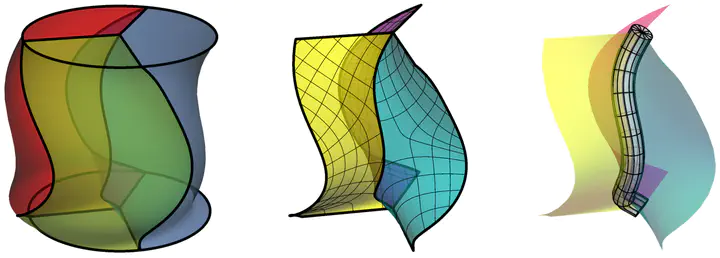Contact line dynamics in three-phase fluids

How does the balance of surface tension and fluid forces lead to evolution laws for the interfaces and junction lines separating three-phase fluids? The motivation for this question comes from analysing nanovial manufacture — where one cares about the nucleation, growth, and coalescence of droplets in phase-separating polymer solutions. A detailed understanding of this process would lead to much more efficient numerical methods for this applied problems, for example.
(Unsurprisingly) I find that it is often useful to understand such questions by considering them as a singular limit of physically motivated systems (just like the volume penalty method, the phase field method, or shocks in fluid dynamics problems). In this particular case, our ‘‘physically motivated model’’ comes from coupling a ternary Cahn-Hilliard equation to the Navier-Stokes equations. \begin{align} \partial_t c_i + u\cdot c_i &= \Delta \left(M_{ij}\frac{\delta f}{\delta c_j}\right),\\ f(c) &= \sum_{j} \frac{\chi_j}{\varepsilon} c_j^2(1-c_j)^2 - \sum_{j,k}\varepsilon\sigma_{jk}\nabla c_j \cdot \nabla c_k,\\ \partial_t u + u\cdot \nabla u &= -\nabla p + \nu \Delta u + \sum_i \mu_i \nabla c_i. \end{align} The question becomes (as always) ‘‘what does this PDE do in the limit $\varepsilon \to 0$’’?
The short answer to the question is ‘‘contact angles come from the Young-Dupre condition’’ (stating that the contact angles are determined by ratios of surface tensions). The problem is that that is only true at equilibrium! In the first movie above we see that starting from a homogeneous initial conditions (like in experiments on nanovial manufacture) the initial contact angles can deviate quite far from equilibrium (in this cases equal angles for equal surface tensions).
The goal then is to understand how these contact angles evolve dynamically. Over what time scales do they relax to equilibrium? What laws quantify the evolution of the geometry? And how can we exploit this knowledge to design interesting new shapes and processes for engineering problems?
The means? Multiple-scales matched asymptotics of course! The interesting new wrinkle is that we not only want to understand singular surfaces at the boundary of two phases, but also singular three-phase curves at the intersection of these two-phase boundaries. Fortunately, we now have the mathematical tools to describe the neighbourhoods of these curves and surfaces using the signed distance function. Then, by breaking the problem into bulk, surface, and curve subproblems, we can come up with a complete solution by stitching these subproblems back together.